How to warm a frozen water supply: an overview of the most effective methods
Is it familiar to you when the tap water supply stops at a negative temperature on the street? Such a problem arises in your house with the onset of a cold pore, but you do not know how to quickly fix it? To fight, you need to choose an effective method of resuming the water supply network. Do you agree?
We will tell you how to warm a frozen pipeline and how to prevent a problem situation in the future. Let's talk about effective methods that allow you to quickly restore the water supply on a cold winter day for sanitary purposes and cooking.
Our article provides a selection of the best ways to help deal with this trouble on your own. The methods for pipelines of various materials are considered. So that you can better understand the nuances of warming, we picked up visual photos and thematic videos with a detailed description of recommendations for saving the water supply from ice captivity.
The content of the article:
Causes of System Freezing
With a sharp onset of frost, supplemented by strong winds, cases of freezing autonomous plumbing systems with the formation of ice plugs inside them, they are often found.
Water frozen as a result of improper installation or operation of the pipeline will, at best, make it impossible to use the system, and at worst, it will force to eliminate the breakthrough.
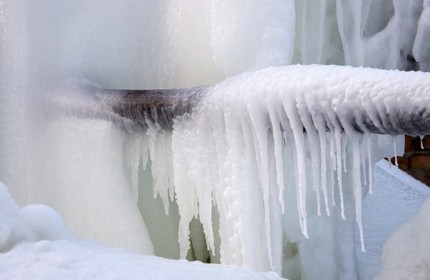
There may be several reasons for the freezing of water in a water supply system.
The most basic among them:
- extremely low outdoor temperatures;
- laying pipes to a shallower depth than the level of soil freezing;
- insufficient insulation of the pipeline;
- low or even zero water consumption.
At night or for a longer period, when the owners do not use the water supply, the water in the pipes remains stationary. At subzero temperatures, it quickly freezes.
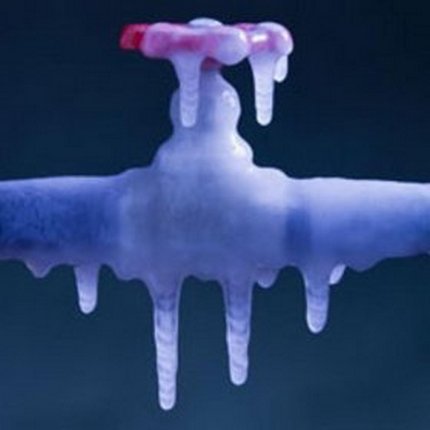
A pipe located in frozen ground, after passing warm streams, begins to cool, and after a short period of time acquires a low temperature. Small portions of water begin to freeze and crystallize as they approach, at some point clogging the entire section of the pipe completely.
How to find a problem area?
The most difficult moment in this matter is to determine the place of freezing in an open area water supply systems. Experienced masters advise when inspecting and probing the accessible part of the route to focus on temperature sensations.
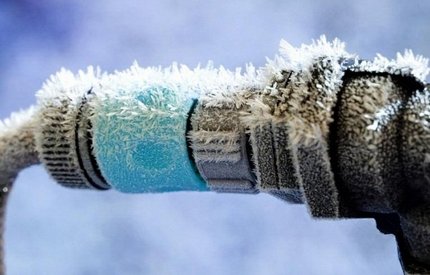
Water pipes usually freeze in areas where pipes come close to the surface of the earth. Vulnerable to frost are also technical wells, unheated basements.
It is noticed that concrete freezes faster than soil strata. Therefore, if the basement was unreliably insulated or ajar during a period of severe frost, it is quite natural that the pipeline running through it froze.

If it is not possible to “calculate” a specific area, use the available methods at once at several most probable freezing places.
Effective solutions to the problem
Water supply can be thawed by external heat, or by defrosting from the inside. Each specific case depends on the length of the frozen area and the material from which water pipes, and therefore requires the use of different means.
Despite the fact that ice with the same mass is more voluminous than water, in the framework of its state of aggregation, subject to the laws of physics, it expands before it melts.
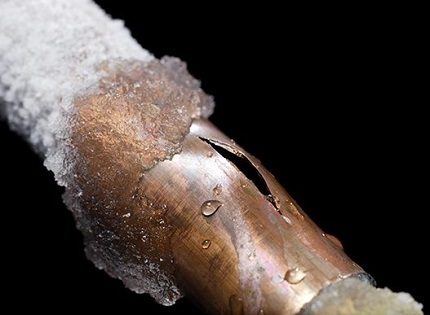
Before starting work, it is mandatory to open the water tap or “vent” after the valve at the inlet in order to determine the effectiveness of the actions taken from the water flowing from it.
Method # 1 - using hot water
If the system freezes in an open area at entering the house, or inside an unheated basement, the easiest way to warm a section of the water supply is to treat it outside with boiling water. Hot water saved water pipes from freezing at all times.
To do this, wrap the pipe in several layers with rags and cuts of old rags that absorb moisture well. A wet rag will extend the contact time of the pipe walls with water.
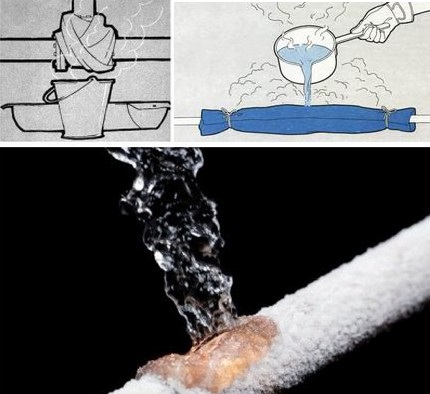
When warming up a frozen section of the pipeline, it is important not to damage it. Areas of construction that do not require heating must be covered with a heat insulating material. This will prevent the accumulation of pieces of ice moving along the pipeline with water.
Apply this method only in enclosed spaces and with the open method of laying the pipeline. And this technology is suitable only for steel pipelines. The system located underground will have to be heated with boiling water for at least 12 hours.
Method # 2 - heating with a building hairdryer
The desired effect can also be achieved with the help of hot air created by a powerful building hair dryer. The method is used for heating frozen sections of the pipeline in those places where it is quite easy to get to them, for example, when the system is laid inside the building.
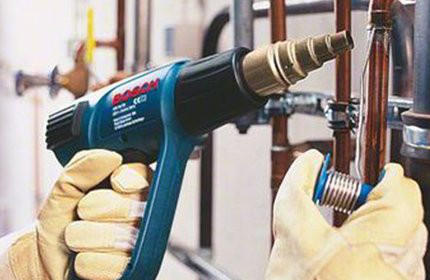
To create conditions for promoting ice accumulation along the pipe, it is necessary to evenly distribute the flow of hot air, without forgetting to open all the valves first.
Consider that the building hair dryer gives out temperature which range can reach from 100 to 650 ° C. Therefore, it cannot be used for pipes made of polymeric materials.
To strengthen the effect, while reducing heat loss, helps the construction of a makeshift protective casing around the heated area. It will reflect heat, evenly distributing it over the entire surface of the insulated area.
For this, a small pavilion is temporarily being built, the walls of which are made of the same film or metal shields.
When warming up the pipeline, special attention should be paid to the fittings inlets, bends and contractions, as even tiny ice floes can get stuck inside them. The main thing is to leave the tap open.
When heating steel pipes, some craftsmen use open fire methods using a gas burner or blowtorch.
But this method can only be used with open visibility of the pipes. And the efficiency of using a blowtorch is not too high, since it can take up to several hours to warm up even a short section.
Method # 3 - using electric current
You can cope with ice caps with a welding machine. The principle of operation of the device is based on the fact that the metal of which the pipe is made is a conductor.
Under the influence of the created electric field, the electrons begin to move in a given direction, colliding with ions, they transfer their energy to them. That, in turn, turns into heat, which is released outside.
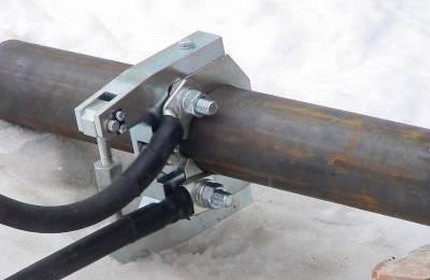
The terminals of the off welding machine are fixed to the ends of the frozen section. First, the power regulator is set to the minimum, and then, gradually increasing it, turn on the equipment for about 30-40 seconds.
After a short pause, the manipulations are repeated. Depending on the degree of freezing, the current can be adjusted less / more. As the power increases, it is necessary to periodically check the degree of wall heating.
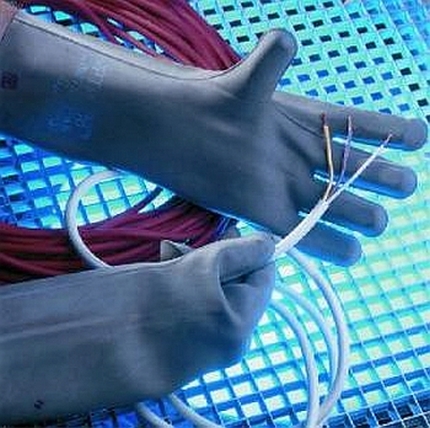
As soon as the process of melting is activated, first one drop, and then a thin stream of water will flow from the tap. There is no need to completely melt the entire site. It is sufficient to provide an uninterrupted thin stream of water. And moving water will already help melt the remnants of not thawed ice.
The welding machine is used only for heating stainless, steel, copper and other types of pipes made of metal alloys. Using the device on polypropylene products is pointless. After all, plastic is not a conductor. The only thing you get in the end is a damaged pipeline.
Method # 4 - “soldier's boiler” for plastic
The easiest way to heat a plastic pipe is to use a two-core copper wire with a cross section of 2.5 mm. By the principle of operation, it is similar to a conventional boiler.
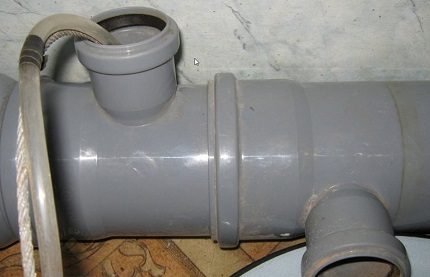
Water, in which salts are present, is a weak electrolyte. Therefore, in order to heat it, it is only necessary to immerse a pair of electrodes into it, and then apply voltage to them.
For this, the conductors of the wire are disconnected:
- The first core is first bent to the side.
- The second core is exposed and wrapped around the pipe, forming 5-6 turns.
- Once again, they take the first core, expose them and wrap them around the pipe in the form of coils.
- Connect the plug to the other end of the wire.
- The created workpiece is pushed into the pipeline until it hits the ice and fed from the mains.
When forming the turns and placing them on the surface of the pipe, it is important to ensure that they do not touch, otherwise a short circuit will occur at the moment of contact. Ideally, the distance between the turns of the wires should be at least 2-3 mm.
You can also use a compressor to blow melt water.
Method # 5 - heating the pipeline from the inside
For extended heating water system pipinghaving several bends in its path, you can apply the method of exposure from the inside. This method is also effective in defrosting sewer pipes.
To make the device you will need:
- elastic wire D2-4 mm;
- hydraulic level tube;
- Esmarch's irrigator;
- bucket;
- insulating tape.
To assemble the structure, the end of the wire is attached to the hydraulic level tube, fixing the elements with electrical tape. To obtain a more rigid structure, the end of the wire is bent. The end of the tube should be 3-5 centimeters longer than the wire.
One end of the tube with the wire is pushed into the water supply until it stops, and the second free end is connected to the Esmarch mug. If the pipeline is connected by fittings, they must be unscrewed in order to assess how frozen the structure is.

Esmarch's mug is filled with hot water and attached to the tube. The hot water flowing out of the rubber tank will enter the pipeline, warming up the icy water in it.
In the process of warming up the pipeline, it is only necessary to push pieces of ice further with a wire.As a result of heat treatment, the water in the receiving bucket should be slightly larger than the volume that was poured for defrosting.
Be prepared for the fact that this method is quite time-consuming. It will take about 60 minutes to warm up one running meter of the pipe. But then the costs of implementing this method are minimal.
This method is a simplified version of washing pipes with hot water, the temperature of which reaches 150 ° C. This procedure is performed by specialized organizations. They carry out preventive flushing of pipes, supplying hot water under high pressure within 100 Atm.
Method # 6 - professional equipment
In winter, when there is an urgent need to enjoy water facilitieswithout spending several hours on her resuscitation, you will have to use professional equipment. The use of special equipment, the apparatus, will help to quickly eliminate the formed ice plugs. "The Dragon".
For this, the mites of the apparatus are connected to the ends of the area to be heated. After checking the fluid pressure in the system, turn on the device for several minutes. Depending on the degree of freezing of the pipes, the period of continuous operation of the device can be 20-40 minutes.
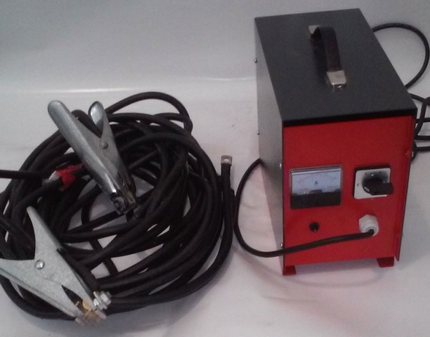
The current generated by the device depends on its modification. Moreover, any model is equipped with effective protection, which ensures electrical safety of the device.
If it is necessary to defrost a long section of the pipeline, experienced craftsmen recommend using several devices at the same time.
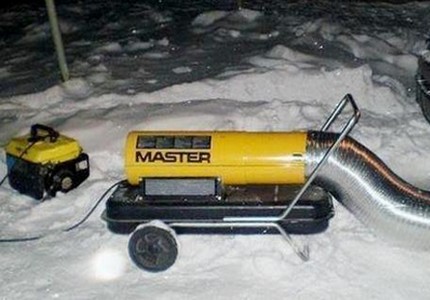
To eliminate ice plugs in plastic pipes, apply steam generators and hydrodynamic flushing apparatus. But they are used only if there is an opportunity to gain access to the inside of the structure.
In addition, this technique is limited by the length of the cable, and therefore, in some situations, the pipeline has to be disconnected.

A heat-resistant sleeve equipped with a nozzle moves along the pipe as the ice melts.
The use of such equipment allows solving two problems at once:
- To clean the inner surface of the pipes from various deposits, thereby improving circulation in the structure.
- Check for leaks over the length of the treated area and, if necessary, neutralize them.
With all the advantages of professional equipment, its main drawback is dimensions and cost. If “Dragon” type electrical appliances can still be purchased or rented, then a steam generator is a special case. Such equipment is more used by professional companies, the services of which will have to be used.
How to prevent system freezing?
The question of the probability of freezing the pipeline must be foreseen at the stage of its laying. According to the current norms of SNiP, pipes must be laid below the freezing depth.

The depth of freezing of the soil layers is determined empirically in the coldest period for the region, taking into account the maximum indicator of soil moisture and provided that there is no snow cover. If it is not possible to lay pipes at a sufficient depth, it is worth taking care of thermal insulation designs.

As a heat insulator, it is perfect:
- polystyrene strips;
- mineral wool;
- glass wool.
It is not worthwhile to use rags, sawdust and paper as a winding, even for temporary insulation. When the temperature changes, these materials easily absorb moisture from the air, preventing the condensate from evaporating.
On sale, you can also find chemicals that prevent freezing of water. But their aggressive composition makes them unacceptable to the plumbing system. It is better to use a concentrated saline solution that perfectly corrodes the ice. It is fed through a hose whose diameter is slightly smaller than the cross-section of the pipeline.
In addition, salt water at a temperature below zero does not freeze, so that the formation of a cork for a salt solution is not exactly expected.
Alternatively, lay along the pipeline heating cable. It is equipped with temperature sensors, which, when the system is heated to a certain temperature, turn it off. The main advantage of self-heating cables is that they are able to adapt to external conditions. And this in no way affects the work of its other parts.

The length of the heating cable can reach 20 meters, due to which it can be used to heat both individual sections of the pipeline and the entire system located in the freezing zone of soils.
Keep in mind that water freezes faster in pipelines with a small diameter. Therefore, when arranging autonomous water supply, it is preferable to use pipes whose diameter is 50 mm and above.
Since concrete freezes much faster than soils, in places where the pipeline passes through a basement or basement, it is advisable to place sections of the pipe in sleeves - pipes with a slightly larger diameter. The resulting voids can be blown out with polyurethane foam.
In the future, with irregular use of utilities during downtime during the cold season, it is necessary to completely remove water from the pipes and keep them in a dry state.
It is necessary to warm not only the pipeline itself, but also itself water source, and other structural elements passing outside the house and in unheated rooms.
Despite the wide selection of effective equipment for removing ice plugs from pipes, it is best not to bring such a problem. After all, heating frozen pipes is a rather problematic process, which is exacerbated by the complexity of performing work in the cold.
Adhering to the recommendations that are simple to follow, you can prevent the pipes from freezing and stopping the system, thereby extending its service life.
Conclusions and useful video on the topic
Video # 1. Overview of the use of heating cable for pipes:
Video # 2. Video review of the heating method using new technologies:
Well, as a last resort, if frost is raging on the street, and the above methods cannot be applied, then try, contrary to safety rules, to leave the crane ajar for the night.
Albeit slow, but still water movement will prevent the formation of ice plugs. And after the warm season has come, we still recommend that you deal with the problem area and thoroughly warm the pipeline.
Want to share your own method of heating the water supply? Found controversial points in the information presented, questions have ripened on the topic of the article? Please write comments in the block below.

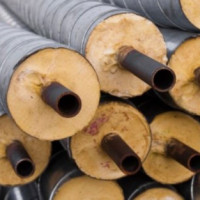 Insulation for heating pipes: overview of types + application examples
Insulation for heating pipes: overview of types + application examples  Features of flushing the heating system: an overview of the best ways
Features of flushing the heating system: an overview of the best ways 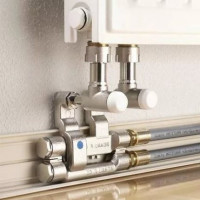 Which pipes are better to choose for heating: a comparative review
Which pipes are better to choose for heating: a comparative review  How to better organize garage heating: a comparative overview of the best ways
How to better organize garage heating: a comparative overview of the best ways 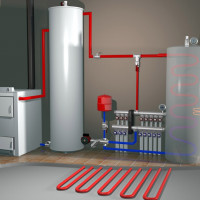 Types of heating systems for a private house: a comparative overview + the pros and cons of each type
Types of heating systems for a private house: a comparative overview + the pros and cons of each type 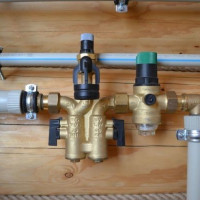 Installation of heating from polypropylene pipes: how to make a heating system from polypropylene
Installation of heating from polypropylene pipes: how to make a heating system from polypropylene  How much does it cost to connect gas to a private house: the price of organizing gas supply
How much does it cost to connect gas to a private house: the price of organizing gas supply  The best washing machines with dryer: model rating and customer tips
The best washing machines with dryer: model rating and customer tips  What is the color temperature of light and the nuances of choosing the temperature of the lamps to suit your needs
What is the color temperature of light and the nuances of choosing the temperature of the lamps to suit your needs  Replacement of a geyser in an apartment: replacement paperwork + basic norms and requirements
Replacement of a geyser in an apartment: replacement paperwork + basic norms and requirements
I myself am from the Volga region. Winters are not so severe here. But here, there are more than enough problems if you do not prepare in time.
Still, I am more inclined to the option of electric heating. Therefore, in his suburban house he invested precisely in a similar method of heat supply to the water supply. It is enough to connect the network and wait a while, if it has been absent for a long time. Of course, there are problems with the current source itself, but it is much easier to survive than exploring the way to troubleshoot the water main itself.
If it froze a little, about 15-20 meters, wind 2 kilowatts, it must be put on for two days.